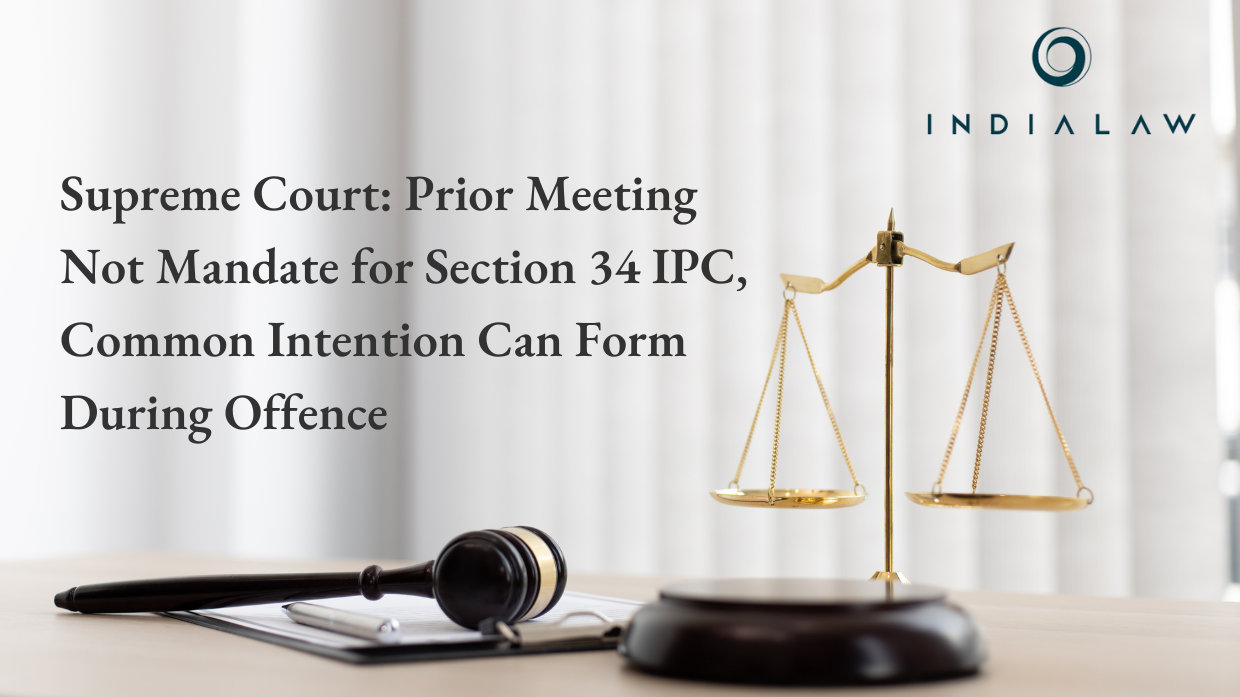Prior Meeting of Minds Not a Mandate to Trigger Section 34 IPC, Common Intention Can Form Even During Commission of Offence: Supreme Court

The Division Bench of the Hon’ble Supreme Court comprising of Justice Abhay S. Oka and Justice Pankaj Mithal in the matter of Ram Naresh v. State of UP has clarified that to attract Section 34 of the Indian Penal Code (“IPC”), there must be a common intention amongst all the co-accused persons, indicating that they have a shared purpose.
The Court further clarified that there is no mandate of an explicit discussions or agreements amongst the co-accused. Common intention amongst the accused persons may arise just prior to commission of the offence.
The Division Bench stressed that “For applying Section 34 IPC there should be a common intention of all the co-accused persons which means community of purpose and common design.”
It further highlighted that “Common intention does not mean that the co-accused persons should have engaged in any discussion or agreement so as to prepare a plan or hatch a conspiracy for committing the offence. Common intention is a psychological fact and it can be formed a minute before the actual happening of the incidence or as stated earlier even during the occurrence of the incidence.”
The Supreme Court was hearing an appeal filed against the order of the Allahabad High Court that upheld the decision of the Trial Court wherein it convicted all the accused persons under Section 302 read with (r.w.) Section 34 IPC for committing murder.
Section 34 of IPC
For ease of readers, Section 34 of the IPC deals with common intention. The Section says a criminal act committed by several people with a common intention makes each person liable for that act as if it was done by him alone.
A person who participated in an offence along with co-accused having a common intention, is sufficient to trigger Section 34. It is not necessary that accused persons conspire together and plan their act before committing the offence. A common intention can be formed even during the course of the offence, it does not require prior meeting of minds.
Facts of the case
Balram and his brother Ram Kishore (victim/ deceased) were attacked by four accused persons. One of the accused was carrying an iron rod, he was along with other accused persons namely Rajaram, Jogendra, and Ram Naresh (appellant), who had lathis. The victim shouted for help but in vain. These four accused gave brutal blows to Ram Kishore from lathis and iron rod. The victim got injured and died.
Based on the FIR lodged against the accused persons, a case was registered under Section 302 (murder) r.w. Section 34 (common intention) of the IPC. The Trial Court convicted all four accused persons under Section 302 r.w. 34 of the IPC. An appeal was filed before the High Court, and it affirmed the decision of the Trial Court.
Being aggrieved, the Appellant filed the present Appeal before the Supreme Court.
The issue before the Supreme Court
Whether the appellant had a common intention under Section 34 of the IPC along with co-accused to kill the victim?
Contentions of the appellant
The Counsel for the appellant argued that the Trial Court did not record any finding regarding “common intention” against the appellant and hence Section 34 of the IPC cannot be triggered against him. It was further stated that even the High Court did not discuss the presence of evidence against the appellant of having a common intention.
Reliance was placed on the case of Krishnamurthy alias Gunodu v. the State of Karnataka[i], by the appellant. However, the Supreme Court noted that the said decision held relevance for the prosecution’s case and not the appellant.
The appellant also relied on the case of Jasdeep Singh alias Jassu v. the State of Punjab 2022 LIVELAW (SC) 19, and the Court rejected the same.
Findings of the Court
The Court, after considering the evidence on record stated that all accused persons were armed, they collectively assaulted the victim, that caused his death and subsequently all four left the crime spot together.
It noted that “The intention kill him is discernible from the very fact that all of them are related to each other and were armed when they came to the place of occurrence. All the accused persons, on the instigation of Rajaram simultaneously attacked the deceased Ram Kishore and thereafter left together. Thus, according to the findings of the trial court all the four accused persons had come to the place of occurrence together armed with weapons, assaulted the deceased Ram Kishore simultaneously and left the place together”.
Decision of the Court
In the light of the above, the Division Bench dismissed the appeal and clarified that mere common intention of all accused persons would not trigger application of Section 34 of the IPC. However, while considering the case in hand and analyzing the evidence it is concluded that the appellant had participated actively in the assault, and hence, he had a shared common intention with other co-accused persons to cause harm to the victim.
[i] 2022 LiveLaw (SC) 220
By entering the email address you agree to our Privacy Policy.



